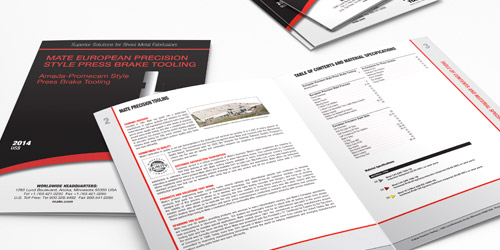Preserve Small Forms with Relieved Blanking Tools
Solution Bulletin
The Problem:
Sheet metal parts often include small forms such as tabs or embosses. These forms are often created prior to the part being punched or blanked from the sheet metal. How can you perform a blanking operation without deforming or destroying these small forms in the finished part?
The Mate Solution:
Custom designed tooling with reliefs will allow the pre-made forms to be included in the part, ultimately preventing any damage to occur in the forms. The small forms may be placed directly into the sheet metal before the part is blanked out. This allows small forms to be processed in a punch press rather than in
a secondary operation such as a press brake. Including a relief in the tooling allows the forms to enter the relieved area of the tool as the blanking hit is being processed. This prevents the forms from being damaged or crushed during the blanking operation. Large areas can be relieved to accommodate multiple forms
for a part or an area specific to a particular form.
The following recommendations will assist in making good quality blanks:
- Inform your Mate Customer Service representative that the tooling will be used for blanking.
- The slug is the final product, so tooling should be ordered with this in mind.
- The die (including clearance) should be the part size. The punch dimensions will then be calculated based on the die size.
- Reduce the die clearance by 5% (a Mate Applications Specialist can help you with calculations based on material type and thickness). The reduced die clearance helps to increase the burnish area and minimize the dimensional difference between the top and bottom of the blanked part.
- Provide Mate with an accurate reference drawing of the part. Critical information will include the height of the forms, as well as length, width and location on the final part.
- Use only sharp punches and dies. This increases the straight or burnished portion of the blank to provide straighter walls on the required parts.
- Punches should be flat faced if possible.
- Use straight taper dies.
- Inspect tools frequently for wear. With reduced die clearances, frequent inspection and sharpening is required.

